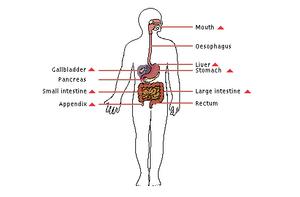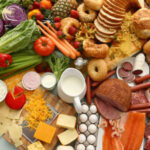INTRODUCTION
DIGESTION is the process by which complex food materials are broken down into simple food materials. In Human alimentary canal mainly three parts are involved in digestion and these are a) Buccal cavity, b) Stomach and c) Small intestine.
Mainly three types of foods are digested in Human alimentary canal, these are :
a) Carbohydrate b) Protein and c) Fat.
DIGESTION IN BUCCAL CAVITY
A. Digestion of Carbohydrate in buccal cavity :
1. Both mechanical and chemical digestion of complex carbohydrate starts in the buccal cavity. The mechanical process which breaks the food
materials and mixes with saliva is called chewing. The product of which is called Bolus.
2. Human Saliva contains inorganic and organic chemical compounds. The most important amylolytic enzyme secreted in buccal cavity by the salivary
glands (Parotid gland, Submaxillary gland and sublingual gland) is Ptyalin or salivary amylase which is a weak enzyme.
3. Mode of action of Ptyalin is given below :
A. Boiled starch + Ptyalin = Soluble starch ;
B. Soluble starch + Ptyalin = Erythrodextrin + Maltose ;
C. Erythrodextrin + Maltose + Ptyalin = Acrodextrin + Maltose ;
D. Acrodextrin + Maltose + Ptyalin = Isomaltose + Maltose.
4. Although Ptyalin reacts with starch in the buccal cavity, but the action of Ptyalin also occurs in the stomach before the concentration of HCl becomes
adequate.
B. Digestion of Protein and fat in buccal cavity :
1. Due to absence of proteolytic and lipolytic enzyme in saliva, protein and fat digestion do not occur in the buccal cavity. But, Lingual lipase is found recently in
the saliva.
Note : Lysozyme is an enzyme present in the saliva that does not take part in the digestion but kills the germs (mainly bacteria) of food. Saliva also contains an
enzyme called Kallikrein that acts on plasma protei to produce Bradykinin.
DIGESTION IN STOMACH
A. Digestion of Carbohydrate in stomach :
1. Due to Peristalsis movement in the oesophagus, the bolus enters into the stomach. The wall of the stomach contains numerous gastric glands which
secrete gastric juice.
2. Mode of secretions of stomach cells are given below :
A. Parietal of stomach secrete cells or Oxyntic cells HCl ;
B. Peptic cells secrete Pepsinogen ;
C. Goblet cells secrete Mucin.
3. Gastric juice does not contain any amylolytic enzymes but gastric HCl hydrolyse to some extent Sucrose to Glucose and Fructose.
4. HCl gives an acidic media into which the enzymes can act easily within the stomach.
5. How is HCl formed in the Stomach ?
HCl is secreted from the parietal cells of the stomach walls from carbonic acid decomposition in presence of Cl¯ ion.
The steps of HCl formation in Stomach are given below :
1. CO2 (from plasma) + H2O = H2CO3 (by Carbonic anhydrase enzyme)
2. H2CO3 = H+ + HCO3¯
3. H+ + Cl–(from plasma) = HCl
B. Digestion of Protein in stomach :
1. Pepsinogen, the proenzyme of Pepsin is secreted from peptic cells of stomach, changed to active pepsin by gastric HCl.
2. Pepsin hydrolyses the protein molecules into primary proteoses, then secondary proteoses and peptones.
3. Mode of action of HCl and proteolytic enzymes is given below :
A. Pepsinogen + HCl = Active pepsin;
B. Protein + HCl = Acidmetaprotein;
C. Acid metaprotein + Pepsin = Primary proteose;
D. Primary proteose + Pepsin = Secondary proteose;
E. Secondary Proteose + Pepsin = Peptone.
4. Rennin, in infants, changes the casein of milk to a paracasein which is then acted on by Pepsin. Rennin is absent in the stomach of adults.
C.Digestion of Fat in stomach :
1. Gastric lipase of gastric juice is a weak fat splitting enzyme which hydrolyses each molecule of neutral fat into three molecules of fatty acids and one
molecule of glycerol in acidic medium.
2. Mode of action of gastric lipase is given below :
Fat + gastric lipase = 3 molecules of Fatty acids + 1 molecule of Glycerol
DIGESTION IN SMALL INTESTINE
A. Digestion of Carbohydrate in Small intestine :
1. Duodenum part of the small intestine is the principal site for the digestion of all types of carbohydrates (except monosaccharide and cellulose) with the help
of different amylolytic enzymes present in the pancreatic juice and intestinal juice.
2. Pancreatic amylase acts on both boiled and unboiled starch and converts them into Maltose.
3. Intestinal juice contains different amylolytic enzymes such as intestinal amylase, sucrase, maltase, lactase, trehalase, isomaltase etc.
4. Mode of digestion of carbohydrates are :
A. Starch + Amylase = Dextrin + Isomaltose + Maltose ;
B. Maltose + Maltase = Glucose + Glucose ;
C. Lactose + Lactase = Glucose + Galactose ;
D. Sucrose + Sucrase = Glucose + Fructose ;
E. Trehalose + Trehalase = Glucose ;
F. Isomaltose + Isomaltase = Glucose.
B. Digestion of Protein in Small intestine :
1. Pancreatic juice contains proteolytic proenzymes such as Trypsinogen,Chymotrypsinogen and Proelastase which are converted into Trypsin, Chymotrypsin
and Elastase respectively. The steps are given below :
A. Trypsinogen + Enterokinase = Trypsin ;
B. Chymotrypsinogen + Trypsin = Chymotrypsin ;
C. Proelastase + Trypsin = Elastase.
2. Trypsin changes protein into peptone and few molecules of Amino acids.
3. Chymotrypsin changes peptone into polypeptides and few molecules of Amino acids.
4. Elastase changes proteins into polypeptides.
5. Mode of action of proteolytic pancreatic enzymes are :
A. Protein + Trypsin = alkali metaprotein ;
B. Alkali metaprotein + Trypsin = Primary proteose ;
C. Primary proteose + Trypsin = Secondary Proteose ;
D. Secondary proteose + Trypsin = Peptone ;
E. Peptone + Chymotrypsin = Polypeptides + Amino acids ;
F. Protein + Elastase = Polypeptides.
6. Intestinal juice contains Erepsin which converts Polypeptides into Amino acids.
A. Polypeptide + Erepsin = Amino acids.
C. Digestion of Fat in Small intestine :
1. Complete digestion of fat is done in the duodenum by the Pancreatic Lipase with the help of bile salts (bile is secreted by Liver).
2. The main function of Bile salts is to emulsify fat into small droplets calle misseles and thus Pancreatic Lipase can break ester bonds and converts them
into Fatty acids and Glycerol.
A. Fat + Pancreatic lipase = Fatty acid + Glycerol.
Note : Pancreatic juice contains Amylolytic, Proteolytic as well as Lipolytic enzymes. So Pancreatic juice is called complete digestive juice.
******************






